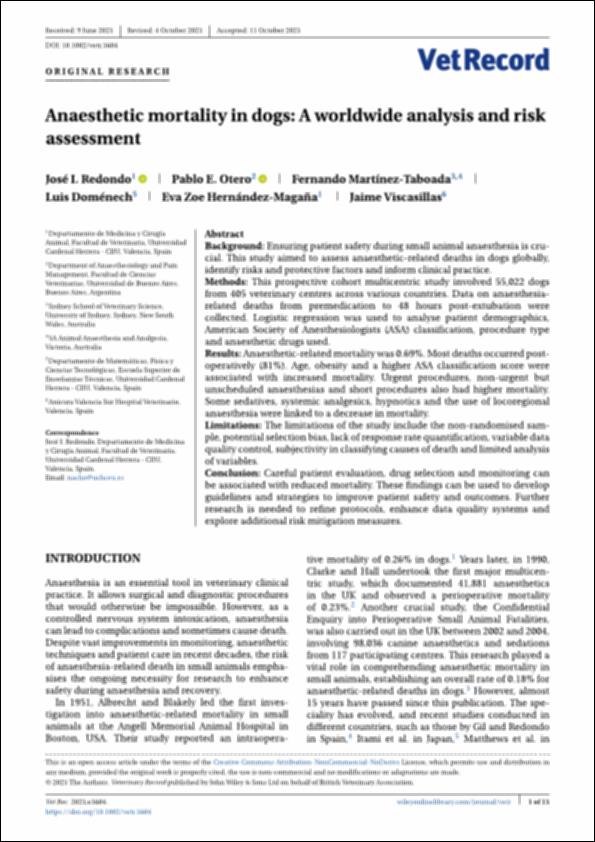Por favor, use este identificador para citar o enlazar este ítem:
http://hdl.handle.net/10637/15519Anaesthetic mortality in dogs: a worldwide analysis and risk assessment
| Título : | Anaesthetic mortality in dogs: a worldwide analysis and risk assessment |
| Autor : | Redondo García, José Ignacio Otero, Pablo E. Martínez Taboada, Fernando Doménech Ballester, Luis Hernández Magaña, Eva Zoe Viscasillas Monteagudo, Jaime |
| Materias: | Mortalidad; Mortality; Anestesia veterinaria; Veterinary anesthesia; Analgesia veterinaria; Analgesia (Veterinary); Perros; Dogs |
| Editorial : | John Wiley & Sons |
| Citación : | Redondo, J.I., Otero, P.E., Martínez-Taboada, F., Doménech, L., Hernández-Magaña, E.Z. & Viscasillas, J. (2023). Anaesthetic mortality in dogs: a worldwide analysis and risk assessment. Veterinary Record, art. e3604. Advance online publication. DOI: https://doi.org/10.1002/vetr.3604 |
| Resumen : | Background:Ensuring patient safety during small animal anaesthesia is cru-cial. This study aimed to assess anaesthetic-related deaths in dogs globally,identify risks and protective factors and inform clinical practice.Methods:This prospective cohort multicentric study involved 55,022 dogsfrom 405 veterinary centres across various countries. Data on anaesthesia-related deaths from premedication to 48 hours post-extubation werecollected. Logistic regression was used to analyse patient demographics,American Society of Anesthesiologists (ASA) classification, procedure typeand anaesthetic drugs used.Results:Anaesthetic-related mortality was 0.69%. Most deaths occurred post-operatively (81%). Age, obesity and a higher ASA classification score wereassociated with increased mortality. Urgent procedures, non-urgent butunscheduled anaesthesias and short procedures also had higher mortality.Some sedatives, systemic analgesics, hypnotics and the use of locoregionalanaesthesia were linked to a decrease in mortality.Limitations:The limitations of the study include the non-randomised sam-ple, potential selection bias, lack of response rate quantification, variable dataquality control, subjectivity in classifying causes of death and limited analysisof variables.Conclusion:Careful patient evaluation, drug selection and monitoring canbe associated with reduced mortality. These findings can be used to developguidelines and strategies to improve patient safety and outcomes. Furtherresearch is needed to refine protocols, enhance data quality systems andexplore additional risk mitigation measures. |
| URI : | http://hdl.handle.net/10637/15519 |
| Derechos: | http://creativecommons.org/licenses/by-nc-nd/4.0/deed.es Open Access |
| ISSN : | 0042-4900 2042-7670 (Electrónico) |
| Cubierto por: | Acuerdo Transformativo - 2023 |
| Fecha de publicación : | 2023 |
| Centro : | Universidad Cardenal Herrera-CEU |
| Aparece en las colecciones: | Dpto. Medicina y Cirugía Animal |
Los ítems de DSpace están protegidos por copyright, con todos los derechos reservados, a menos que se indique lo contrario.


